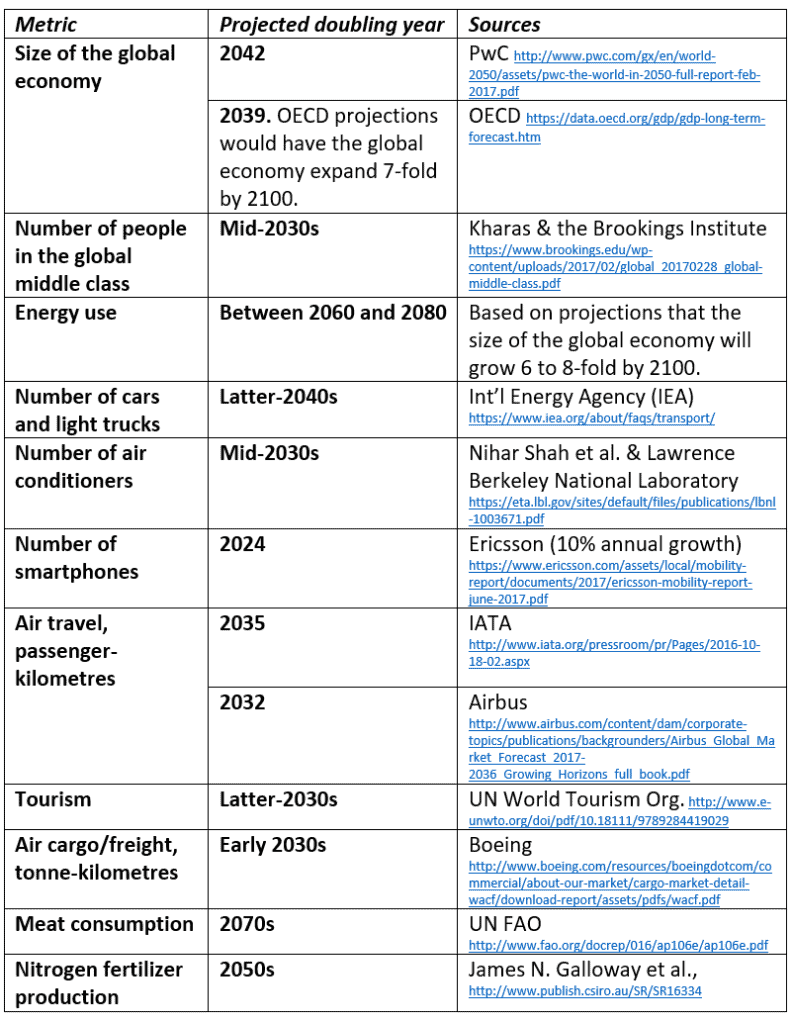In February 2017, global accounting firm PricewaterhouseCoopers (PwC) released a report on economic growth entitled The Long View: How will the Global Economic Order Change by 2050? The graph above is based on data from that report. (link here) It shows the gross domestic product (GDP) of the largest economies in the world in 2016, and projections for 2050. The values in the graph are stated in constant (i.e., inflation adjusted) 2016 dollars.
PwC projects that China’s economy in 2050 will be larger than the combined size of the five largest economies today—a list that includes China itself, but also the US, India, Japan, and Germany.
Moreover, the expanded 2050 economies of China and India together ($102.5 trillion in GDP) will be almost as large as today’s global economy ($107 trillion).
We must not, however, simply focus on economic growth “over there.” The US economy will nearly double in size by 2050, and Americans will continue to enjoy per-capita GDP and consumption levels that are among the highest in the world. The size of the Canadian economy is similarly projected to nearly double. The same is true for several EU countries, Australia, and many other “rich” nations.
Everything must double
PwC’s report tells us that between now and 2050, the size of the global economy will more than double. Other reports concur (See the OECD data here). And this doubling of the size of the global economy is just one metric—just one aspect of the exponential growth around us. Indeed, between now and the middle decades of this century, nearly everything is projected to double. This table lists just a few examples.

At least one thing, however, is supposed to fall to half
While we seem committed to doubling everything, the nations of the world have also made a commitment to cut greenhouse gas (GHG) emissions by half by the middle decades of this century. In the lead-up to the 2015 Paris climate talks, Canada, the US, and many other nations committed to cut GHG emissions by 30 percent by 2030. Nearly every climate scientist who has looked at carbon budgets agrees that we must cut emissions even faster. To hold temperature increases below 2 degrees Celsius relative to pre-industrial levels, emissions must fall by half by about the 2040s, and to near-zero shortly after.
Is it rational to believe that we can double the number of cars, airline flights, air conditioners, and steak dinners and cut global GHG emissions by half?
To save the planet from climate chaos and to spare our civilization from ruin, we must—at least in the already-rich neighborhoods—end the doubling and redoubling of economic activity and consumption. Economic growth of the magnitude projected by PwC, the OECD, and nearly every national government will make it impossible to cut emissions, curb temperature increases, and preserve advanced economies and stable societies. As citizens of democracies, it is our responsibility to make informed, responsible choices. We must choose policies that curb growth.
Graph source: PriceWaterhouseCoopers


The inconvenient truth!
a few of the things that will reduce growth:
1.build communities so people can walk or cycle instead of using cars or transit.
2. Improve transit so people can use instead of cars,
3. Use EVs instead of combustion vehicles to reduce use of energy in moving and reduce maintenance and repairs,
4. Use renewable energy sources of energy that are plentiful and usually free instead of fossil fuel sources,
5. Insulate buildings so they will use very little energy to operate.
6. Grow your own food,
7. Prevent flooding and storm damage by slowing global warming.
Gosh I could go on and on and comfort and pleasure will only increase with less production
A great list of vital initiatives. Thanks, David.